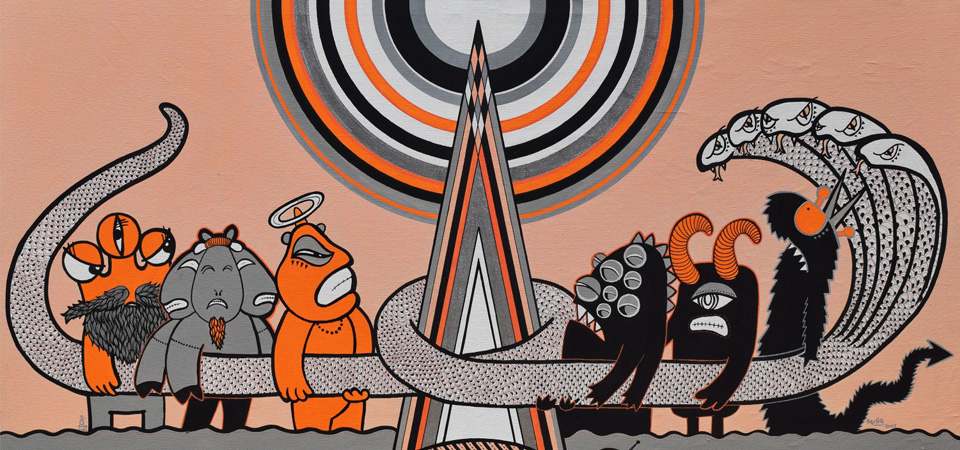Kathmandu Triennale 2077: Redefining what we consider art

Kathmandu, Mar. 2: The celebration of art and artists working with and from within multiple aesthetic and cosmological perspectives and manifesting the multiplicities that construct our global reality have opened in the form of Kathmandu Triennale 2077.
The Triennale – an exhibition featuring the works of more than 130 national and international artists in five venues in Kathmandu and Lalitpur – was formally inaugurated on Tuesday by Minister for Culture, Tourism and Civil Aviation Prem Bahadur Ale.
On the occasion, Ale called it very necessary to preserve and promote Nepal’s art and culture. With his ministry being one of the organisers of the Triennale, along with the Siddhartha Arts Foundation in partnership with the contemporary art centre Para Site, Hong Kong, Minister Ale stressed on the need to establish Nepal as a cultural tourism destination and give a platform to indigenous art and artists.
The latter is of particular pertinence that sadly, does not get enough prominence is exhibitions. “Too often, when we think of art, we think of a specific kind of art, ones that are western or European made by artists like Picasso or van Gogh,” Sheelasha Rajbhandari, one of the curators of the exhibition told The Rising Nepal during a press tour Sunday. “Native arts are often relegated to the status of handicrafts or vocation; the knowledge, skill and intricacy that go into making them are disregarded.”
Shedding light on Rajbhandari’s point are devotional artist Chet Kumari Chitrakar’s paintings on display at Patan Museum. The 69-year-old prints images of gods and goddesses for festivals like Nag Panchami and Laxmi Puja. Yet people purchasing these images from her and traditional painters like and adorning their doorways with it seldom think of these as art pieces.
“Why is that?” Rajbhandari asked. “In a country of artisans, we have adopted a euro-centric view of art that excludes most of our own,” she said, explaining the perspective that the triennial fest sought to change.
Pieces by Venezuela’s Sheroanawe Hakihiiwe and New Zealand’s Nikau Hindin, among several other artists, also highlight this perspective.
Emphasising the indigenous is the Triennale’s name too, which includes the date 2077. It was a conscious choice, explained Rajbhandari, to base the programme firmly within Nepal by using the Nepali calendar system.
But why 2077 when we are in the year 2078? “It is because this edition of the Triennale was supposed to happen in 2077,” said Sangeeta Thapa, founder chair of Kathmandu Triennale and founder director of the Siddhartha Arts Foundation. “COVID-19 forced us to postpone the event but we wanted to keep the original date as a memento of the struggles we all went through last year.”
Similarly, this year, the Kathmandu Triennale also focuses on themes of marginalisation, gender identification as well as migration. Through the multidimensional artworks it presents, the exhibition raises the use of Dalit musicians as means of entertainment during celebrations for the so-called upper caste people and highlights the dispossession of migrants by countries who do not hesitate to utilise their labour.
Every aspect of Kathmandu Triennale, including the venues, seeks to evoke, provoke and lead people to understand or at least view art in the context of things around it. This is reflected in its choice of venues. “The five venues represent three curatorial clusters,” Rajbhandari described.
“The first cluster includes Bahadur Shah Baithak and Patan Museum and it seeks to put art within the frame of the strategies that were formulated for the expansion of Nepal (Bahadur Shah being one of the heroes of national unification).
The second is the Nepal Art Council and the Siddhartha Art Gallery which are located at Maitighar – the centre of political debate, and the third is the Taragaon Museum at Bouddha which represents the politics of agriculture.”
The exhibition also heightens our reality up a few notches, making the real surreal as evidenced by a celestial Makar spouting water into electrical grids and the valley of dispossession which hits the viewer with its message of indigenous rights like a bus.
The latest edition of Kathmandu Triennale, which began life in 2009 as the Kathmandu International Art Festival, is open to the public till March 31.
Recent News

Do not make expressions casting dout on election: EC
14 Apr, 2022
CM Bhatta says may New Year 2079 BS inspire positive thinking
14 Apr, 2022
Three new cases, 44 recoveries in 24 hours
14 Apr, 2022
689 climbers of 84 teams so far acquire permits for climbing various peaks this spring season
14 Apr, 2022
How the rising cost of living crisis is impacting Nepal
14 Apr, 2022
US military confirms an interstellar meteor collided with Earth
14 Apr, 2022
Valneva Covid vaccine approved for use in UK
14 Apr, 2022
Chair Prachanda highlights need of unity among Maoist, Communist forces
14 Apr, 2022
Ranbir Kapoor and Alia Bhatt: Bollywood toasts star couple on wedding
14 Apr, 2022
President Bhandari confers decorations (Photo Feature)
14 Apr, 2022









